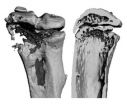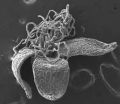(Press-News.org) A study by researchers from Hospital for Special Surgery has shown that platelet-rich plasma (PRP) holds great promise for treating patients with knee osteoarthritis. The treatment improved pain and function, and in up to 73% of patients, appeared to delay the progression of osteoarthritis, which is a progressive disease. The study appears online, ahead of print, in the Clinical Journal of Sports Medicine.
"This is a very positive study," said Brian Halpern, M.D., chief of the Primary Care Sports Medicine Service at Hospital for Special Surgery, New York City, and lead author of the study.
Several treatments for osteoarthritis exist, including exercise, weight control, bracing, nonsteroidal anti-inflammatories, Tylenol, cortisone shots and viscosupplementation, a procedure that involves injecting a gel-like substance into the knee to supplement the natural lubricant in the joint. A new treatment that is being studied by a small number of doctors is PRP injections. PRP, which is produced from a patient's own blood, delivers a high concentration of growth factors to arthritic cartilage that can potentially enhance healing.
"You take a person's blood, you spin it down, you concentrate the platelets, and you inject a person's knee with their own platelets in a concentrated form," said Dr. Halpern. "This then activates growth factors and stem cells to help repair the tissue, if possible, calm osteoarthritic symptoms and decrease inflammation."
In the new study, researchers at Hospital for Special Surgery enrolled patients with early osteoarthritis, gave them each an injection of PRP (6-mL), and then monitored them for one year. Fifteen patients underwent clinical assessments at baseline, one week, and one, three, six, and 12 months. At these time points, clinicians used validated tools to assess overall knee pain, stiffness and function, as well as a patient's ability to perform various activities of daily living. At baseline and then one year after the PRP injection, physicians also evaluated the knee cartilage with magnetic resonance imaging (MRI), something that has not previously been done by researchers in other PRP studies. The radiologists reading the MRIs did not know whether the examination was performed before or after the PRP treatment.
"The problem with a lot of the PRP studies is that most people have just used subjective outcome instruments, such as pain and function scores," said Hollis Potter, M.D., chief of the Division of Magnetic Resonance Imaging at Hospital for Special Surgery, another author of the study. "But even when patients are blinded, they know there has been some treatment, so there is often some bias interjected into those types of studies. When you add MRI assessment, it shows you the status of the disease at that time, regardless of whether the patient is symptomatic or asymptomatic or they have good or poor function in the knee. You find out what the cartilage actually looks like. We can noninvasively assess the matrix or the building blocks of cartilage."
While previous studies have shown that patients with osteoarthritis can lose roughly five percent of knee cartilage per year, the HSS investigators found that a large majority of patients in their study had no further cartilage loss. "The knee can be divided into three compartments, the medial compartment, the lateral compartment and the patellofemoral compartment," said Dr. Halpern. "If we look at these compartments individually, which we did, in at least 73% of these cases, there was no progression of arthritis per compartment at one year. That is very significant, because longitudinal studies suggest a four to six percent progression of arthritis at one year."
Treatment with PRP was also useful in improving pain, stiffness and function. The investigators found that pain, measured by a standard test called the Western Ontario and McMaster Universities Arthritis Index, significantly improved with a reduction of 41.7% at six months and 55.9% at one year. On a pain scale commonly used by clinicians called the Visual Analog Scale, pain was reduced by 56.2% at six months and 58.9% at one year. Functional scores improved by 24.3% at one year. Activity of Daily Living Scores also showed a significant increase at both six months (46.8%) and one year (55.7%).
"We are entering into an era of biologic treatment, which is incredibly ideal, where you can use your own cells to try to help repair your other cells, rather than using a substance that is artificial," Dr. Halpern said. "The downside is next to zero and the upside is huge." Dr. Halpern pointed out, however, that the study is a small case series and PRP needs to be pitted against a traditionally treated group in a randomized, controlled trial.
### Osteoarthritis, which causes pain and joint stiffness, impacts over 27 million Americans and is a leading cause of disability. According to statistics from the Centers for Disease Control and Prevention, overall osteoarthritis affects 13.9% of adults aged 25 and older and 33.6% of those older than 65. The disease is characterized by degeneration of cartilage and its underlying bone within a joint as well as bony overgrowth. Disease onset is gradual and usually begins after the age of 40.
Other HSS investigators involved in the study include Salma Chaudhury, M.D., Ph.D, Scott Rodeo, M.D., Catherine Hayter, MBBS, Eric Bogner, M.D., and Joseph Nguyen, MPH.
About Hospital for Special Surgery
Founded in 1863, Hospital for Special Surgery (HSS) is a world leader in orthopedics, rheumatology and rehabilitation. HSS is nationally ranked No. 1 in orthopedics, No. 3 in rheumatology, No. 10 in neurology and No. 5 in geriatrics by U.S. News & World Report (2012-13), and is the first hospital in New York State to receive Magnet Recognition for Excellence in Nursing Service from the American Nurses Credentialing Center three consecutive times. HSS has one of the lowest infection rates in the country. From 2007 to 2011, HSS has been a recipient of the HealthGrades Joint Replacement Excellence Award. HSS is a member of the NewYork-Presbyterian Healthcare System and an affiliate of Weill Cornell Medical College and as such all Hospital for Special Surgery medical staff are faculty of Weill Cornell. The hospital's research division is internationally recognized as a leader in the investigation of musculoskeletal and autoimmune diseases. Hospital for Special Surgery is located in New York City and online at www.hss.edu.
For more information contact:
Phyllis Fisher
212-606-1197
FisherP@hss.edu
Tracy Hickenbottom
212-606-1197
HickenbottomT@hss.edu
Platelet-rich plasma treatment shows potential for knee osteoarthritis
2013-02-13
ELSE PRESS RELEASES FROM THIS DATE:
Detecting cocaine 'naturally'
2013-02-13
This press release is available in French.
Montréal, February 13, 2013 – Since the beginning of time, living organisms have developed ingenious mechanisms to monitor their environment. As part of an international study, a team of researchers has adapted some of these natural mechanisms to detect specific molecules such as cocaine more accurately and quickly. Their work may greatly facilitate the rapid screening—less than five minutes—of many drugs, infectious diseases, and cancers.
Professor Alexis Vallée-Bélisle of the University of Montreal Department of Chemistry ...
UTHealth: Alcohol consumption may be in response to smoking cessation
2013-02-13
HOUSTON – (Feb.12, 2013) – New findings by researchers at The University of Texas Health Science Center at Houston (UTHealth) School of Public Health may help identify situations in which smokers who are trying to quit are at a higher risk of relapse.
More than 1,200 people die in the United States every day from smoking-related illnesses. This is equivalent to three airplanes loaded with passengers crashing everyday in America. Smoking-related illnesses are the No. 1 cause of preventable deaths in the country, killing more Americans than drugs, homicides, suicides, ...
UCSB study of cocaine addiction reveals targets for treatment
2013-02-13
(Santa Barbara, Calif.) –– Scientists at UC Santa Barbara are researching cocaine addiction, part of a widespread problem, which, along with other addictions, costs billions of dollars in damage to individuals, families, and society. Laboratory studies at UCSB have revealed that the diminished brain function and learning impairment that result from cocaine addiction can be treated –– and that learning can be restored.
Karen Szumlinski, a professor in the Department of Psychological & Brain Sciences at UCSB, and her colleagues Osnat Ben-Shahar and Tod Kippin, have worked ...
Emerging cancer drugs may drive bone tumors
2013-02-13
Cancer drugs should kill tumors, not encourage their spread. But new evidence suggests that an otherwise promising class of drugs may actually increase the risk of tumors spreading to bone, according to researchers at Washington University School of Medicine in St. Louis.
The drugs, IAP antagonists, block survival signals that many cancer cells rely on to stay alive. Working in mice, the investigators found that targeting the same protein that makes tumors vulnerable to death also overactivates cells called osteoclasts, which are responsible for tearing down bone.
"These ...
Flu outbreaks modeled by new study of classroom schedules
2013-02-13
Classroom rosters combined with human-networking theory may give a clearer picture of just how infectious diseases such as influenza can spread through a closed group of people, and even through populations at large. Using high-school schedule data for a community of students, teachers, and staff, Penn State University's Marcel Salathé, an assistant professor of biology, and Timo Smieszek, a post-doctoral researcher, have developed a low-cost but effective method to determine how to focus disease-control strategies based on which individuals are most likely to spread the ...
Does race make a difference in monitoring of opioid pain therapy?
2013-02-13
Philadelphia, PA, February 12, 2013 – Opioids are frequently prescribed for pain management in noncancer patients, but recommended clinical guidelines for monitoring effectiveness and signs of drug abuse are often not implemented. Alongside well-documented racial disparities in prescribing opioid medications for pain, researchers report racial differences in the use of recommended opioid monitoring and follow-up treatment practices. The study is published in the current issue of PAIN®.
"In our study, we examined whether racial disparities exist in a more comprehensive ...
Ice age extinction shaped Australian plant diversity
2013-02-13
Researchers have shown that part of Australia's rich plant diversity was wiped out by the ice ages, proving that extinction, instead of evolution, influences biodiversity.
The research led by the University of Melbourne and University of Tasmania has shown that plant diversity in South East Australia was as rich as some of the most diverse places in the world, and that most of these species went extinct during the ice ages, probably about one million years ago.
The team's work was published in the prestigious journal Proceedings of the National Academy of Sciences.
Dr ...
Flood research shows human habits die hard
2013-02-13
New research has come up with ways to quickly assess flood damage to houses while also showing most people didn't intend to make changes to reduce their vulnerability after the 2010-11 floods in Australia.
Two separate reports from the National Climate Change Adaptation Research Facility released today show how lessons learned from households affected by the 2010-11 Australian floods can minimise damage under current and future climates.
The report Analysis of Damage to Buildings Following the 2010 Eastern Australia Floods evaluated the role of development controls ...
Blackbirds in the spotlight
2013-02-13
This press release is available in German.
Street lamps, traffic lights and lighting from homes are causing a rise in our night-time light levels. For some time now, scientists have suspected that artificial light in our towns and cities at night could affect plants, animals and us, humans, too. Studies, however, that have tested this influence directly are few. Scientists from the Max Planck Institute for Ornithology in Radolfzell, Germany, recently investigated how light conditions in urban areas at night affect European blackbirds (Turdus merula). They found that animals ...
Copper depletion therapy keeps high-risk triple-negative breast cancer at bay
2013-02-13
NEW YORK (February 13, 2013) -- An anti-copper drug compound that disables the ability of bone marrow cells from setting up a "home" in organs to receive and nurture migrating cancer tumor cells has shown surprising benefit in one of the most difficult-to-treat forms of cancer -- high-risk triple-negative breast cancer.
The median survival for metastatic triple-negative breast cancer patients is historically nine months. However, results of a new phase II clinical trial conducted by researchers at Weill Cornell Medical College and reported in the Annals of Oncology shows ...



